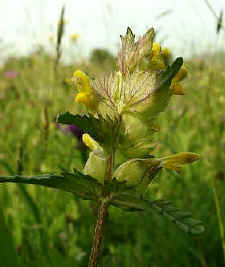Few of the herbs in meadows are dependent on whether the meadow is cut or is grazed. Yellow-rattle (Rhinanthus minor) is one of the few plants which is sensitive to the type of management. This plant is an annual species which is semi-parasitic on the roots of other plants, especially grasses. Hay making favours distribution of its seeds and it is therefore likely to be more widely distributed in fields which are commonly cut for hay. Grazing, rather than hay making, will tend to limit its spread. Clovers are important components of hay fields because they are legumes and are able to fix atmospheric nitrogen in nodules in their roots. This adds relatively small quantities of nitrogen to the soil for use by other plants. Because legumes have their own nitrogen source, their foliage also tends to contain more protein than most grass foliage. This increases the value of the hay as a feed for cattle. The humble Stinging Nettle is another valuable, often overlooked,
component of hay meadows. They are important food plants for several butterflies,
including Peacocks and Red Admirals. With the modern drive for tidiness, nettles are often
in short supply, particularly as butterflies may have specific requirements as to the
position of the nettles and the amount of sunlight they receive. Without suitable food
plants for the caterpillars, the butterfly populations will inevitably decline. Wet, or Water Meadows Soil conditions in wet meadows are quite different to those in dry hay meadows. Poor drainage, or periodic flooding results in saturated soils at some or all times of the year. The air content of these saturated soils is low because all the soil spaces are taken up with water. Plants growing in these areas therefore need to be species which are tolerant of such conditions. As a result of the differences in the soil substrate, the plant communities of wet meadows are substantially different to those in hay meadows. |


